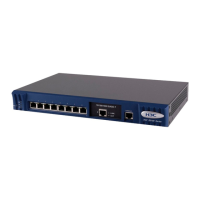1-6
z With the auto match order specified, the newly created rules will be inserted in the existent ones by
depth-first principle, but the numbers of the existent rules are unaltered.
Configuration example
# Configure ACL 2000 to deny packets whose source IP addresses are 192.168.0.1.
<Sysname> system-view
[Sysname] acl number 2000
[Sysname-acl-basic-2000] rule deny source 192.168.0.1 0
# Display the configuration information of ACL 2000.
[Sysname-acl-basic-2000] display acl 2000
Basic ACL 2000, 1 rule
Acl's step is 1
rule 0 deny source 192.168.0.1 0
Configuring Advanced ACL
An advanced ACL can filter packets by their source and destination IP addresses, the protocols carried
by IP, and protocol-specific features such as TCP/UDP source and destination ports, ICMP message
type and message code.
An advanced ACL can be numbered from 3000 to 3999. Note that ACL 3998 and ACL 3999 cannot be
configured because they are reserved for cluster management.
Advanced ACLs support analysis and processing of three packet priority levels: type of service (ToS)
priority, IP priority and differentiated services codepoint (DSCP) priority.
Using advanced ACLs, you can define classification rules that are more accurate, more abundant, and
more flexible than those defined for basic ACLs.
Configuration prerequisites
z To configure a time range-based advanced ACL rule, you need to create the corresponding time
ranges first. For information about of time range configuration, refer to section
Configuring Time
Range
.
z The settings to be specified in the rule, such as source and destination IP addresses, the protocols
carried by IP, and protocol-specific features, are determined.
Configuration procedure
Table 1-3 Define an advanced ACL rule
Operation Command Description
Enter system view
system-view
—
Create an advanced
ACL and enter
advanced ACL view
acl number acl-number
[ match-order { auto | config } ]
Required
config by default
Define an ACL rule
rule [ rule-id ] { permit | deny }
protocol [ rule-string ]
Required
For information about protocol and
rule-string, refer to ACL Commands.
Assign a description
string to the ACL rule
rule rule-id comment text
Optional
No description by default

